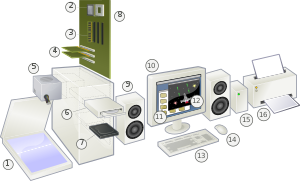
An exploded view of a modern personal computer and peripherals:
The motherboard connects all processor, memory and peripheral devices together. The RAM, graphics card and processor are mounted directly onto the motherboard. The central processing unit microprocessor chip plugs into a socket. Expansion memory plugs into memory sockets. Some motherboards have the video display adapter, sound and other peripherals integrated onto the motherboard. Others use expansion slots for graphics cards, network cards, or other I/O devices. Disk drives for mass storage are connected to the mother board with a cable, and to the power supply through another cable. Usually disk drives are mounted in the same case as the motherboard; formerly, expansion chassis were made for additional disk storage.
The graphics and sound card can have a break out box to keep the analog parts away from the electromagnetic radiation inside the computer case. For really large amounts of data, a tape drive can be used or (extra) hard disks can be put together in an external case.
The keyboard and the mouse are external devices plugged into the computer through connectors on an I/O panel on the back of the computer. The monitor is also connected to the I/O panel, either through an onboard port on the motherboard, or a port on the graphics card.
The hardware capabilities of personal computers can sometimes be extended by the addition of expansion cards connected via an expansion bus. Some standard peripheral buses often used for adding expansion cards in personal computers as of 2005 are PCI, AGP (a high-speed PCI bus dedicated to graphics adapters), and PCI Express. Most personal computers as of 2005 have multiple physical PCI expansion slots. Many also include an AGP bus and expansion slot or a PCI Express bus and one or more expansion slots, but few PCs contain both buses.






0 comments:
Post a Comment